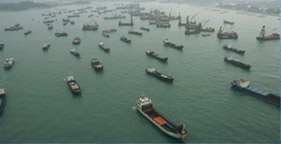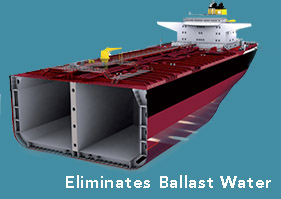









MARKETPLACE
TankerProa Sailing For most of the trans-ocean
voyage the vessel will be propelled
in the down wind direction. As the vessel approaches the
destination anchoring location the
trade winds may not be oriented
for pure downwind sailing , this is
when the capabilities to sail on a
broad reach, and to perform
tacking maneuvers can be utilized to get closer to the destination
port.
After de-coupling from the tanker
vessel the space frame sails to the
local anchoring location associated
with the destination port.
Ballast Water Elimination Tanker vessels that have delivered their liquid cargo, are significantly more unstable against rolling than
when fully loaded.
To offset this
problem they take on ballast water at the port where they have made
their delivery in order to stabilize the vessel for the return trip.
The use of the space frame for this vessel provides the stability required without the need for ballast water, and also eliminates the need for ballast water sterilization equipment.
CO2 Emission Reductions Reduction of diesel fuel usage from full power to diesel engine idling with in-port diesel fuel, reduces amount of fuel used when under pure sail power and consequently CO2 emissions.
Renewable energy generated by the TankerProa used to control both sails,
as well as rudder and dagger board rotations.


